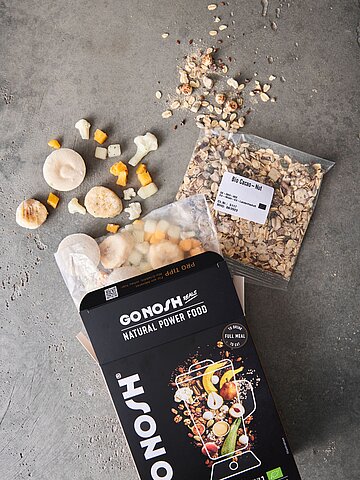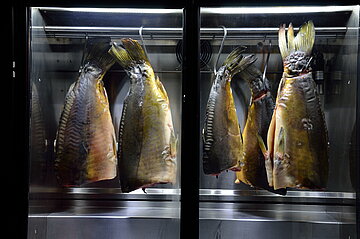Introduction
Meeting consumer tastes has always been a complex task for the food and catering industries. Changes in dietary and eating habits and the emergence of plantarianism, a greater focus on plant-based nutrition, mean the effect of food on the senses is undergoing a major revolution that is redefining the interplay between the senses and culinary indulgence. The research and development institute food & more in Kaarst, run by the internationally renowned trend researcher Karin Tischer, presents detailed findings that are highly relevant for the foodservice and hospitality industry.
A sensory revolution through plantarianism
The increasing prevalence of plant-based diets, including veganism, vegetarianism and flexitarianism, means that many consumers have either not tasted the traditional flavour of animal products for a long time or even have never done so. This change marks a silent revolution with regard to taste as one of the senses, as the established reference values are disappearing. The variety of plant-based diets and alternatives to meat, fish, eggs and dairy products is getting bigger all the time, and shaping the sensory perception of large sections of society in a complex way.
This process poses many challenges for the food production industry. The quality of plant-based alternatives varies a great deal. The producers aim to develop protein alternatives in such a way that they can no longer be distinguished from the original in terms of how they are perceived by the senses, be that in terms of taste, texture or appearance. If successful, this would allow consumers and restaurant guests to opt for a vegan, vegetarian or animal-based option without having to accept any sensory compromises.
Convenient and easy: small, to drink and to go
Consumers’ growing penchant for convenience has led to a trend towards small portions, soft breads and healthy drinks. All foods that can be eaten easily and quickly without a lot of biting or chewing. New drinking rituals have also developed: takeaway meals now come in drinking bottles. Companies like GONOSH are setting new standards by combining frozen fruits and vegetables with dried muesli to create wholesome liquid meals.
New flavours
Spiciness is a fixed and essential element of many national cuisines, but that is not the case in Germany. However, a trend towards spiciness is developing, especially in combination with sweet flavours. This has given spiciness a fresh twist and the corresponding sweet and spicy sauces, chutneys and relishes, which are used together with foods such as burgers, hot dogs and wraps, open up new culinary possibilities. Examples include sweet and spicy creations such as gochujang mayo, pineapple kimchi, date and harissa tahini, tomatillo guacamole, yuzu wasabi, cheddar cranberry cream, apple horseradish, mango mustard and chipotle salsa. Chili chocolate, a combination that is already well established and whose popularity continues to grow, is also part of the ‘swicy’ (sweet and spicy) trend, as it is called in Australia.
Umami represents the ultimate taste experience and gives plant-based cuisine in particular the flavour kick that can otherwise be missing. With that in mind, there is increased focus on umami-rich ingredients such as mushrooms (especially fermented ones), seaweed, legumes and microgreens in the preparation of vegan and vegetarian dishes.
Reduced’ food and beverages
Modern nutrition is largely being shaped by the trend towards health optimisation through the reduction or elimination of sugar, salt and alcohol, driven in particular by Generation Z. This ‘NoLo’ (e.g. no/low alcohol) approach affects both the food and beverage and hospitality industries.
High-level indulgence
The pursuit of an outstanding, ‘high-level’ culinary experience has led to raised standards on the part of guests and inspired innovative developments in gastronomic terms. One notable example is the shift from dry-aged beef to dry-aged fish, which offers an intense taste experience. Restaurants such as Jing Jing in Hamburg, known for its dry-aged hamachi (Japanese yellowtail), Rosso in Linz with its dry-aged kingfish, and Rutz in Berlin, which offers dry-aged carp and roe, are setting new standards for discerning palates and helping to shape an era of culinary innovation in the process.
Significance and lessons for the foodservice and hospitality market
The importance of the senses, especially taste, is increasingly becoming a fundamental element in the foodservice and hospitality market. Meeting the tastes of consumers has always been a complex task, but that has been further exacerbated by changing dietary habits and new trends. The silent sensory revolution brought about by the increase in plant-based nutrition has further complicated the challenge of finding the balance between appealing to the senses and providing culinary enjoyment.
Younger guests, especially those in Generation Z, are complicating matters further with a trend towards reducing or eliminating sugar, salt and alcohol. Providers in the foodservice and hospitality market can rise to the challenge by offering their guests a suitably diverse range of products. This includes the growing spectrum of plant-based and protein alternatives, regardless of whether they are convenience products or freshly prepared. Key elements in satisfying these increased demands on the part of consumers include the use of various flavour intensifiers such as mild spiciness, the ‘swicy’ combination, a kick of umami, the use of fermented ingredients and ‘high-level’ indulgence, for example through dry-aged fish.
Summary: the future of taste and other senses
The sensory revolution brought about by plant-based nutrition brings with it new challenges and opportunities for the food and catering industries. Companies that adapt to these developments and offer innovative, tasty solutions will thrive in the changing culinary landscape. It is time to understand and actively shape the silent taste revolution as we enter a new era for the senses.
Karin Tischer and INTERNORGA FoodZoom
Karin Tischer, the internationally recognised food trend researcher and founder of the food & more research and development institute in Kaarst, compiles the annual INTERNORGA FoodZoom trend analysis for the foodservice and hospitality market on behalf of INTERNORGA. It provides an exciting summary of the food and beverage trends that are shaping the industry. food & more has been developing concepts, innovations and recipes for industry, the foodservice and hospitality market (from large-scale systems to start-ups), B2B providers and retailers for 27 years and is involved in trend research worldwide.
Karin Tischer’s Pink Cube has been the trend forum at INTERNORGA for 11 years and will be presented on the Open Stage for the first time in 2024.





